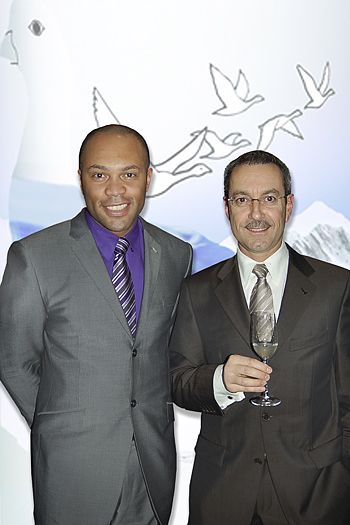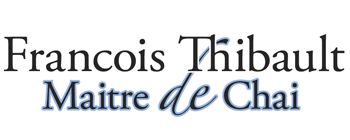Grey Goose’s Maitre de Chai

Dimi Lezinska the Grey Goose global brand ambassador, recently accompanied Francois Thibault on a visit to Boston. Francois, who goes by the title maitre de chai (translation: cellar master), played a key role in the development of Bacardi’s Grey Goose. With Dimi serving as translator, we got the lowdown on how, conscripted from the Cognac world over a decade ago, he turned an idea hatched by former Grey Goose owners Sidney Frank Importing into a worldwide phenomenon.
Francois has done a good deal of traveling throughout the past decade. He’s been to most continents and seen Grey Goose prominently displayed on shelves in bars, restaurants and watering holes he never would have fathomed when he created the recipe about 11 years ago. The stunning contemporary success of Grey Goose as a brand can be traced back to Cognac and the age-old spirit’s heritage and distilling methods. Francois, who grew up near Cognac, spent many years studying wine throughout Bordeaux and Burgundy. His studies in those regions earned him what Dimi refers to as a “degree in wine”. Armed with that, Francois returned to Cognac and made spirits at Mounier. As with all those who start a career in a Cognac distillery, he worked as part of a team and learned the vintage craft under the maitre de chai, essentially the mastermind behind a Cognac house’s distilling and blending. He spent ten years at Mounier, learning the intricacies of distilling and the tricks around how to give a spirit the qualities that differentiate it from other Cognacs. In other words: the proprietary secrets. When Sidney Frank joined forces with Mounier, Francois worked on producing one of its Cognacs, Jacques Cardin. Not long after, Sidney Frank proposed to produce a vodka with the same attention to artisanship that was given their brandy.
“Sidney Frank had a working relationship with Cognac houses. Based on that relationship, the company was immersed in the region. They understood the value and tradition of the region,” Dimi translated as Francois spoke in a luxe salon room of the new l’Espalier in Boston just before a small crowd of local media arrived for a meet and greet session. “Once Sidney Frank saw the opportunity to make Grey Goose, the company realized they had to produce it. The question of who to make it was obvious: Francois. Sidney Frank had the marketing all sorted out. The strong point that was put forward was about the quality. They wanted to use 1OO% French wheat.
Region is really important, it’s like terroir: the wheat is grown where it’s never too hot or too cold. It has good protein and starch content. Francois was friendly with a pastry chef working at a five-star hotel, which had opened in Paris in 1911, who was using the same type of wheat in his baking, so we’re talking about making the vodka with a raw ingredient that’s really coveted by one of the best pastry chefs. Once you have the raw ingredient, then you can develop the process.”
That process, Francois explained, involves the requisite fermentation, with one distinction: Grey Goose was the first among vodka distilleries to ferment with proprietary yeast. Distillation, Francois continued, is the art of creating and concentrating the aromas of Grey Goose. They use a five-column still, so every batch undergoes five steps to conclude the “evolution of the spirit,” as Francois terms it. The stills are all different sizes and temperatures and the spirit enters each column at a different proof. In essence, the process – from raw ingredient to finished product – reflects Francois’s application of his knowledge of Cognac distilling.
“He never imagined the success,” Dimi added. “For him it was always about the quality. The first part was the creation from Francois and his team. Success with consumer came through bartenders, sales teams and marketing. Whether it’s music or painting, it always comes down to the people whether or not they like it. Francois created the recipe 11 years ago. He’s a high keeper of tradition and values. The motto where he’s from is: ‘I drink our fathers’ Cognac, but I make my son’s.’ At Grey Goose, we’re very lucky because we have a maitre du chai. From a young age it was very important to him, and he was very interested in everything that has to do with sense and flavors. His father encouraged him to go into wine studies, and he went off to other parts of France and then back to Cognac. He was always interested in being a maitre du chai. Now it’s 25 years later. What he did for Cognac he applied to Grey Goose when it comes to the methods to concentrate quality and create aromas specific to Grey Goose.”
Beyond – or perhaps because of – the grade A raw materials and distillation method, Grey Goose, which Bacardi acquired in June 2OO4, has managed to set a standard and spark a trend in the vodka category that has long been reserved for other spirits.
The following day, Francois and Dimi paid a visit to Gaslight, the French brasserie in Boston’s South End, and lunched with a number of local on-premise beverage directors, distributors and sales reps. We had an opportunity to continue our discussion about the brand’s impact on the industry. “When he thought and reflected, he realized he could make a vodka that would be 1OO% French,” Dimi said, resuming his role as translator. “A lot of people try to copy, copy, copy what he makes. Francois always thought it most important to have the ability to let imagination flow. From there he decided to immerse himself in the product. He wanted to create it and own it. You’re more capable when doing your own thing than when you’re copying. Understanding wheat and having an accurate production method, he created something that’s perfect.”
While Grey Goose was not the first vodka brand to make a lasting mark on the flavored vodka market segment, Francois explains the development of the flavored vodkas as the result of creative collaboration and unconventional influences. Grey Goose La Poire, for instance, was an upshot of his friendship with the wheat-centric Parisian pastry chef, who made a variety of desserts with fruit. The baker’s pear tarte inspired Francois to look at the association of pear and wheat.
Francois went on to wax somewhat whimsical about his approach to distilling. He spoke with broad gestures and tapped his toes jovially to Ray Charles and Edith Piaf songs as they filled the restaurant. “He’s more into alchemy than chemistry,” Dimi translated. “Chemists have transformations by synthetic chemicals. Alchemists transform ingredients naturally by themselves. You extract quality. In a way, yes, the way French perceive and conceive Grey Goose is different from the world before. It did add something to the vodka category. When you look at the perception before Grey Goose came onto the market, it was an industrial spirit. Grey Goose takes a different look. Now people get to meet the maker, which was unheard of in vodkas. It’s an evolution from the way it was seen before.”
Paul Westerkamp, Beverage Director at 33 Restaurant & Lounge in the Back Bay, echoed that sentiment and points to evidence in his day-to-day operations. “When you put Grey Goose into something, it sells,” said Paul, who was at the lunch. “I think a lot of the success comes from being in the right place at the right time. In the 199Os when Grey Goose came out, there was no French backlash – like what happened later with ‘freedom fries’ and all that. Everyone loved the French. Everyone wants to be French. And the product was something very good – it’s light, the packaging was right. It’s clean and easy to understand. Everyone saw it in magazines. Once you put the brand’s name on a drink on your drink list, everyone added a $2 to $3 profit margin on it. Now it’s the benchmark of what everyone gravitates to, what everyone tries to get to.”
What’s particularly interesting is how that “benchmark”, from Francois’s perspective, in a way still stands in contrast to the messages that many vodka brands aim to communicate. While distillation – especially with regard to clear spirits – is synonymous these days with refinement and removing impurities, Francois prefers that not be the message he drives home with Grey Goose. “It’s not about what you remove that’s important,” Francois spoke exactingly. “It’s more about concentrating on quality. For every imperfection you want to remove, you remove two quality elements.” Dimi explained that Francois would like to be remembered as someone who’s not focused on what he removes: “That’s his philosophy, his state of mind. Coming from Cognac, everyone is first concerned with quality, so you depend on attention to detail and rigor. His vision in making Cognac is what he applies to Grey Goose. It’s like adopting a child, but it’s still family.”

